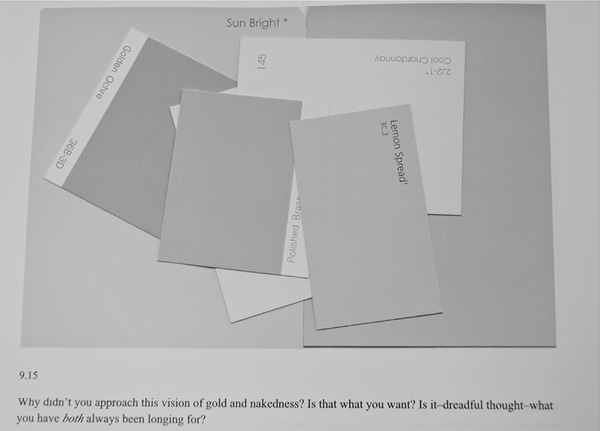
THE VIVISECTOR ORACLE: A COLOR SYSTEM FOR THE DISCOVERY OF TRUTH FOR ARTISTS AND OTHERS IN TIMES OF UNCERTAINTY
first performed on May 29, 2012
School of Art Lecture Theatre, Australian National University
performed ten times in 2012
KIRSTEN FARRELL
John Pratt, Jan Hogan, Genevieve Swift, Helen Ennis, Rebecca Mayo, Raquel Ormela, Caroline Huff, Alison Munro, Sarah Rice, Jay Koche
Canberra, Australia
349754155k349754155i349754155r349754155s349754155t349754155e349754155n349754155.349754155f349754155a349754155r349754155r349754155e349754155l349754155l349754155@349754155a349754155n349754155u349754155.349754155e349754155d349754155u349754155.349754155a349754155u
kirstenfarrell.com
THE VIVISECTOR ORACLE: A COLOR SYSTEM FOR THE DISCOVERY OF TRUTH FOR ARTISTS AND OTHERS IN TIMES OF UNCERTAINTY
KIRSTEN FARRELL
I invented “The Vivisector Oracle” by making a sequential list, with page numbers, of all the colours from the novel The Vivisector by Patrick White. The protagonist of The Vivisector, Hurtle Duffield, is an Australian modernist artist whose preoccupation with truth in art overshadows and foils any relationship upon which he embarks.
I found over 2,000 color terms in the novel. My color list allows some contextual description, for example “golden flesh” or “sour greenish yellow” as well as simple color terms like “black” or “red.” Using house paint swatches from hardware stores I interpreted the list as closely as I could and made a series of collages with the paint swatches and index cards. These are arranged into ten “chapters,” corresponding to the novel; altogether there are 206 cards. Next, I reread _The Vivisector _and for each collage determined an oracular reading from the pages where the colors originated.
When a viewer engages “The Vivisector Oracle,” I ask them to think of a question, something about which they are uncertain, and to choose up to ten cards to which they feel drawn. I consult my remixed text and deliver the “reading.” The viewer usually tries to interpret and extract meaning from the text, relative to the question they had in mind. I have found that even someone who is skeptical of occult divination systems tries to construct a meaningful connection between their own question and the often quite obscure oracle text.
“The Vivisector Oracle” was not conceived as a performative work, but as the work developed and the documents were exhibited, some viewers requested “readings” with me. The audience and the work demanded a performance of each other. In this way I became a channel, facilitating the performance. I came to realize that the effect of the work was in the interaction with viewers, in their own reception of the meaning of the “readings” and in my delivery. Also important is my bearing witness to their interpretation of the “reading.” After two public performances, I realized that the work is to be performed for one person at a time. Since then I have performed private oracles in my studio. The performance is ongoing and continues to grapple with problems of truth, fiction and uncertainty. “The Vivisector Oracle” enacts the way in which people construct meaning and unravel problems faced in their daily life.